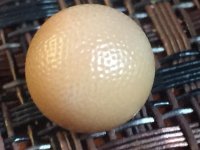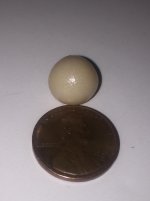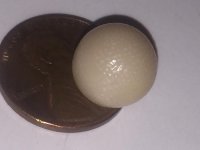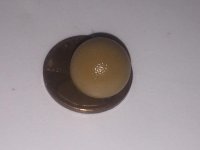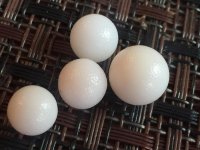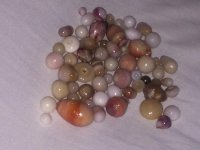You are using an out of date browser. It may not display this or other websites correctly.
You should upgrade or use an alternative browser.
You should upgrade or use an alternative browser.
Natural Spondylus Princeps Pearls
- Thread starter edrodrivaz
- Start date
Pearl Dreams
Pearl Enthusiast
Goodness, that looks like a golf ball!
What size is that?
What size is that?
BWeaves
Well-known member
I thought golfball, too. It's interesting.
amti
Community member
I would love to see the pearl from a distance too!
Pearl Dreams
Pearl Enthusiast
Here is one on The Pearl Collector website, 10 x8 mm:
http://www.thepearlcollector.com/6-92ct-spondylus-pearl/
http://www.thepearlcollector.com/6-92ct-spondylus-pearl/
Lady_Disdain
Member
Such a cool pearl. There is always so much to learn about pearls and I love seeing these unusual types.
Lagoon Island Pearls
Well-known member
- Joined
- Dec 8, 2009
- Messages
- 2,143
All scallops are Order: Pectinoida in taxonomy. Pearl oysters are Order: Pterioida. Mussels are Order: Mytiloida. (the "oida" suffix means having a shell)
Oyster and mussel shells (and pearls) are largely structured in layers of terraced aragonite and protein. Hence they may be defined as highly nacreous. All mollusks (and some annelids) are considered nacreous, but some to a greater degree than others, particularly Class: Cephalopod and some Class: Nudibranch, which have evolved away from shells, favoring mobility.
Scallops stray from this type of structure. Their shells have nacreous surfaces, but only where soft tissues attach and along margins of new growth. Very soon during each growth cycle, they'll structure their shells (and pearls) with foliated calcite. It's every bit as strong as other structures and quite elegant in different ways. Nacreous surfaces are like tiles on a floor or bricks in a wall, where foliated calcite appears more like rose pedals or fan shapes with a deck of cards.
Oyster and mussel shells (and pearls) are largely structured in layers of terraced aragonite and protein. Hence they may be defined as highly nacreous. All mollusks (and some annelids) are considered nacreous, but some to a greater degree than others, particularly Class: Cephalopod and some Class: Nudibranch, which have evolved away from shells, favoring mobility.
Scallops stray from this type of structure. Their shells have nacreous surfaces, but only where soft tissues attach and along margins of new growth. Very soon during each growth cycle, they'll structure their shells (and pearls) with foliated calcite. It's every bit as strong as other structures and quite elegant in different ways. Nacreous surfaces are like tiles on a floor or bricks in a wall, where foliated calcite appears more like rose pedals or fan shapes with a deck of cards.
edrodrivaz
Collector of Pearls
GemGeek
Pearlista
Fascinating!
edrodrivaz
Collector of Pearls
Katbran
Well-known member
Wow ... never seen anything like this ! Really interesting! Thanks for posting !
edrodrivaz
Collector of Pearls
Katbran
Well-known member
Quite fascinating really !
edrodrivaz
Collector of Pearls
Hi.
More Pearls Spondylus.
Awesome! They look like small golf balls to me because of the surface texture
Similar threads
- Replies
- 14
- Views
- 3K
- Replies
- 26
- Views
- 1K

